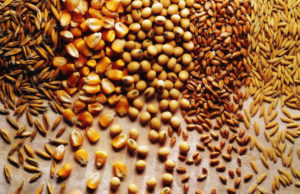 Grain futures were higher on Thursday with wheat and soybeans marking moderate gains, while corn rebounded after earlier losses to trade slightly above its previous close, pressured by concern for ample supply.
Grain futures were higher on Thursday with wheat and soybeans marking moderate gains, while corn rebounded after earlier losses to trade slightly above its previous close, pressured by concern for ample supply.
On the Chicago Mercantile Exchange, corn futures for September delivery traded at $5.7438 a bushel at 9:40 GMT, up 0.14% on the day. Prices ranged between days high and low at $5.7475 and $5.7163 a bushel respectively. The grain has declined for the last five days and a sixth would be the worst streak since November 15. The contract has dropped more than 13% so far this week.
Bill Gary, the president of Commodity Information Systems in Oklahoma City said corn yields may average 156 bushels an acre this year, the third highest on record, despite the fact the number of acres sown to corn was 1.9% lower than Marchs forecast, standing at 95.431 million. Production is expected to surge to 13.62 billion bushels, compared to 10.78 billion last year.
Corn crumbled around 12% on Monday, prior to USDA’s report in which the agency said that 96% of the nation’s corn crop has emerged as of June 23, up from the preceding week’s 92%. This, however, was lower than the last year’s 100% during the comparable week and the five-year average of 99%.
As for the corn crop condition, quality has remained overall the same in comparison to the previous week, but a lot better than last year’s crop. As of June 23, 8% of the crop fell in the “Very poor” and “Poor” categories, 27% in “Fair” and 65% were categorized as “Good” and “Excellent”. In 2012, 14% of the crop was of “Very poor” and “Poor” quality, 30% “Fair” and the remaining 56 was “Good” and “Excellent”.
Wheat gains
Wheat gained on Thursday, trading at $6.8225 a bushel at 9:36 GMT, up 0.72% on the day. Prices ranged between days high and low at $6.8238 and $6.7613 respectively. The grain recorded a weekly gain during last week when the dollar pushed all dollar-priced commodities down, boosted by Fed’s latest statement. The grain drew support as harvesting in the U.S. was delayed due to rains, despite ample supply forecasts from Australia, Russia and Ukraine’s Black Sea region and Europe.
According to USDA’s report, 20% of the winter wheat crop was harvested as of June 23, up from the prior week’s 11%. This, however, is well below last year’s 63% and the five-year average 37% reading.
Winter wheat condition remained almost unchanged in comparison to last week, but is worse than last year’s. As of June 23, 43% of the crop was categorized as “Very poor” and “Poor”, 25% was “Fair” and 31% “Good” and “Excellent”. Last year’s readings stood at 17% “Very poor” and “Poor”, 29% “Fair” and the remaining 44% “Good” and “Excellent”.
As for the spring wheat, the USDA said in its report that 96% of the crop was planted, compared to 92% in the previous week and below last year and the five-year average readings of 100% and 99% respectively. As of June 23, 90% of the spring wheat had emerged, 6% above the previous week, but below last year’s 100% and the five-year average reading of 97%.
Soybeans gain as well
Soybeans also marked daily gains, trading at $14.2913 a bushel at 9:40 GMT. The oilseed surged 0.25% on the day, ranging between days high at $14.2963 and low of $14.2150. Soybeans marked a 1.66% weekly loss last week and are currently down 4.17% during the last four days as a record domestic output is expected in the U.S., while demand from China, the biggest consumer, is expected to falter amid the countrys economic slowdown in the short-term.
The U.S. Department of Agriculture will publish its planting and stockpiles reports on June 28. According to a Bloomberg survey among 34 analysts, U.S. farmers probably have planted 77.811 million acres of soybeans this year, up from March’s projection of 77.126 million. Domestic output is expected to be at a record level following last year’s drought that hurt supplies.
The U.S. Department of Agriculture said in its report on Monday that as of the week ending June 23, 92% of the U.S. soybeans crop was planted, up from the previous week’s 85%. However, this is below the five-year average of 95% and last year’s 99% during the comparable week.
The agency also reported that 81% of the crop emerged up to June 23, well above the prior week’s 66%, but still below the five-year average of 89% and last year’s 98% reading.
Soybean condition is overall better this year, compared to 2012. Soybeans of “Very poor” and “Poor” quality totaled 7% of the crop, 28% was of “Good” condition and 65% was categorized as “Good” and “Excellent”. Last year’s readings stood at 15% for “Very poor” and “Poor”, 32% for “Fair” and the remaining 53% was in the premium categories.





